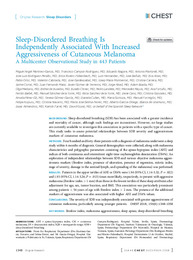Por favor, use este identificador para citar o enlazar este ítem:
https://hdl.handle.net/11000/34977Registro completo de metadatos
| Campo DC | Valor | Lengua/Idioma |
|---|---|---|
| dc.contributor.author | Martinez-Garcia, Miguel Ángel | - |
| dc.contributor.author | Campos-Rodríguez, Francisco | - |
| dc.contributor.author | Nagore, Eduardo | - |
| dc.contributor.author | Martorell, Antonio | - |
| dc.contributor.author | Rodriguez-Peralto, José Luis | - |
| dc.contributor.author | Riveiro-Falkenbach, Erica | - |
| dc.contributor.author | Hernandez, Luis | - |
| dc.contributor.author | Bañuls, José | - |
| dc.contributor.author | Arias, Eva | - |
| dc.contributor.author | Ortiz, Pablo | - |
| dc.contributor.author | Cabriada, Valentin | - |
| dc.contributor.author | Gardeazabal, José | - |
| dc.contributor.author | Montserrat, Josep Maria | - |
| dc.contributor.author | Carrera, Cristina | - |
| dc.contributor.author | Corral, Jaime | - |
| dc.contributor.other | Departamentos de la UMH::Medicina Clínica | es_ES |
| dc.date.accessioned | 2025-01-18T13:00:22Z | - |
| dc.date.available | 2025-01-18T13:00:22Z | - |
| dc.date.created | 2018-12 | - |
| dc.identifier.citation | Chest . 2018 Dec;154(6):1348-1358 | es_ES |
| dc.identifier.issn | 0012-3692 | - |
| dc.identifier.uri | https://hdl.handle.net/11000/34977 | - |
| dc.description.abstract | Background: Sleep-disordered breathing (SDB) has been associated with a greater incidence and mortality of cancer, although such findings are inconsistent. However, no large studies are currently available to investigate this association in patients with a specific type of cancer. This study seeks to assess potential relationships between SDB severity and aggressiveness markers of cutaneous melanoma. Methods: Four hundred and forty-three patients with a diagnosis of melanoma underwent a sleep study within 6 months of diagnosis. General demographics were collected, along with melanoma characteristics and polygraphic parameters consisting of the apnea-hypopnea index (AHI) and indices of both continuous and intermittent night-time oxyhemoglobin desaturation (DI4%). An exploration of independent relationships between SDB and various objective melanoma aggressiveness markers (Breslow index, presence of ulceration, presence of regression, mitotic index, stage of severity, damage to the sentinel lymph, and spreading of the melanoma) was performed. Results: Patients in the upper tertiles of AHI or DI4% were 1.94 (95% CI, 1.14-3.32; P = .022) and 1.93 (95% CI, 1.14-3.26; P = .013) times more likely, respectively, to present with aggressive melanoma (Breslow index > 1 mm) than those in the lowest tertiles of these sleep attributes after adjustment for age, sex, tumor location, and BMI. This association was particularly prominent among patients < 56 years of age with Breslow index > 2 mm. The presence of the additional markers of aggressiveness was also associated with higher AHI and DI4% values. Conclusions: The severity of SDB was independently associated with greater aggressiveness of cutaneous melanoma, particularly among younger patients. | es_ES |
| dc.format | application/pdf | es_ES |
| dc.format.extent | 10 | es_ES |
| dc.language.iso | eng | es_ES |
| dc.publisher | Board | es_ES |
| dc.rights | info:eu-repo/semantics/openAccess | es_ES |
| dc.rights | Attribution-NonCommercial-NoDerivatives 4.0 Internacional | * |
| dc.rights.uri | http://creativecommons.org/licenses/by-nc-nd/4.0/ | * |
| dc.subject | breslow index | es_ES |
| dc.subject | melanoma aggressiveness | es_ES |
| dc.subject | sleep apnea | es_ES |
| dc.subject | sleep-disordered breathing | es_ES |
| dc.title | Sleep-Disordered Breathing Is Independently Associated With Increased Aggressiveness of Cutaneous Melanoma.A Multicenter Observational Study in 443 Patients | es_ES |
| dc.type | info:eu-repo/semantics/article | es_ES |
| dc.relation.publisherversion | 10.1016/j.chest.2018.07.015 | es_ES |

Ver/Abrir:
Sleep-Disordered Breathing Is Independently.pdf
393,4 kB
Adobe PDF
Compartir:
 La licencia se describe como: Atribución-NonComercial-NoDerivada 4.0 Internacional.
La licencia se describe como: Atribución-NonComercial-NoDerivada 4.0 Internacional.
.png)